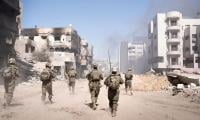There is no one single principal source of instability and conflict in the wider MENAPA region (Middle East, North Africa, Pakistan & Afghanistan).
Internally, this region offers the perfect, unceasing storm of economic, social, and political diversity that fuels vulnerability. Externally, repeated foreign interventions have assured a constant supply of weapons, incentives and triggers for war.
Israel, the American invasion of Iraq, and the global thirst for cheap oil all bear some of the blame for the mess. But the region’s history has no shortage of defining moments that have helped frame, instigate and sustain the multiple crises that afflict MENAPA. This is why single target or single source analyses of the assassination of Iran’s General Qassim Soleimani are dangerous and misleading.
Dangerous and misleading is bad enough for a normal MENAPA country, but it is triply so for Pakistan. First, for the last forty years it has directly suffered (and participated in) a conflict in Afghanistan. It has also endured, for almost exactly the same duration of time, a Persian-Arab proxy war that may have originally been rooted in the post-1973 global OPEC geopolitics, but has come to encompass a wide array of local and global cleavages, amongst which, most relevant for Pakistan has been the transplantation of an inorganic sectarian divide into its society.
Second, over the last quarter century, it has had to try to manage the growing religious extremism that shapes India and its politics, at home and abroad. Third, and perhaps most of all, throughout its existence Pakistan has suffered from institutions that seek to expand the breadth and depth of their power, with no concurrent growth in capacity to deal with present challenges.
This growing delta between institutional ambition and operational incompetence has produced four pillars of this particular state that are all constantly in flux, within themselves and, often, between each other: a colonial-overlord, yet disconnected and incompetent civilian bureaucracy; a political uber elite that, when push comes to shove, knows only how to negotiate and secure the interests of its own family members and loyalists; a brave, but insecure and wildly understaffed judiciary that – in the absence of resources and capacity – chooses to deploy symbolism as an instrument of creating and sustaining its political capital; and a highly capable military that seeks the strongest say in the management of the economy, foreign policy and other matters of extreme importance.
Pakistan’s preparation for the post Qassim Soleimani world are therefore clouded not by one or two or three factors, but by a galaxy of competing incentives, distractions, fears, anxieties and ambitions.
The starting point for Pakistan’s preparation is to clearly identify and prioritise its interests in Iran. Identifying and classifying Pakistani interests in Iran and with respect to Iran is not an act of ambition or assertion, but a vital step in securing Pakistan’s legitimate interests. What are these interests?
Strategically, Pakistan has been aligned with the United States and Saudi Arabia, based on a seventy-year record of mixed, but reliable, strategic triangulation that is designed to address Pakistan’s principal threat: India. As long as India continues to be the primary adversary, Pakistan will seek to engage the US as a source of security and economic support, even if the US gradually becomes a secondary strategic partner to China.
Saudi Arabia, for all its faults, has been the only unconditional supporter of the Pakistani economy, with at least three occasions in the last quarter century when deferred payments (read: grants) for Saudi oil helped Pakistan avoid default. At least three million remittance-sending Pakistani labourers in Saudi Arabia and its smaller GCC allies further cement the deep connection between the House of Saud and the Pakistani elite. This strategic alignment is unlikely to change in the short to medium term. Nor should it.
Iran has, to its credit, sought to engage with Pakistan, with an acceptance that such a strategic alliance is a Pakistani imperative. But it has not privileged this engagement with Pakistan over its own primary domestic and foreign/external/regional (whatever suits the context best) strategic objectives. This is tricky for Pakistan – but both countries have dealt with one another, for the most part, with phenomenal patience and understanding. This patience has been tested and was made to run extremely thin by Iran’s pursuance of ‘strategic depth’ in the region.
Economically, Iran is a top five producer of both oil and gas, and thus represents a source of energy with the three qualities that a country should seek in their sources of energy: proximity, price, and predictability. Iran and Pakistan first signed an agreement for a pipeline that connects the South Pars gas field to Pakistan, with one section going through urban Sindh, and the other through southern Punjab, and onwards to India. This pipeline, which had its origins in discussions between scientists from India and Iran, came to be known as the IPI Gas Pipeline.
In 2008, bilateral deliberations between Iran and Pakistan on the IPI pipeline reached a crescendo, with the then Iranian president Ahmedinejad at one point reportedly stating that “Iran and Pakistan are like one soul in two bodies” – the kind of flowery language that tends to only be used between Turkey and Pakistan, and very, very occasionally (when an Afghan leader is in the mood) between Afghanistan and Pakistan. Not soon thereafter, Lisa Curtis (now a senior US State Department official) published a paper with two colleagues at the Heritage Foundation titled, ‘The Proposed Iran-Pakistan-India Gas Pipeline: An Unacceptable Risk to Regional Security’.
The IPI pipeline survived the Musharraf era, and continued to garner public policy attention under President Zardari. As recently as 2012, Pakistan was an integral part of two separate but equally important regional initiatives involving Iran (a trilateral meeting with Afghanistan, and the August OIC meeting at which Zardari helped ensure Iran’s attendance, and at which King Abdullah and then Iranian president Ahmedinejad eventually sat together).
The JCPOA gave optimists in New Delhi and Islamabad hope that the IPI pipeline may be made easier, and President Xi’s 2015 visit to formally launch CPEC (which was delayed because of the PTI’s 2014 dharna), included references to financing for an Iran Pakistan pipeline. But largely because of Pakistani disengagement, there has been almost no progress on the pipeline since 2016. It is not difficult to surmise why Pakistan is unwilling to upset the US for the sake of this pipeline – but the IPI pipeline is central to understanding the lukewarm soul of Pakistan and Iran.
Culturally, Pakistanis have mostly been denied their Persian heritage, largely because of the twin combination of strategic and economic disengagement between their country and a post-revolution Iran that has privileged other interests. Urdu is much more a derivative of Persian than it is of any other language. The richest vein of Urdu poets’ work tends to either fully partake in, or extravagantly flirt with Farsi. The holiness and reverence that Pakistanis associate with the religious, spiritual and cultural heritage of Iranians is unmatched, with ziarat through Iran a yearning common to all Hussainis, whether Sunni or Shia.
Pakistan’s leaders must frame Pakistan’s preparation for a post-Soleimani world through the legitimate long-term strategic, economic and cultural interests Pakistan has in Iran. Clear, dispassionate and consistent policy is the best way to mitigate against the massive risks that have been unleashed by yet another episode in the long drama of America’s reckless behaviour in the Middle East.
The writer is an analyst and commentator.
A representational image showing residents walking at a wholesale market in Karachi. — AFP/FileOnce again there is...
A representational image showing late Pakistani human rights activist and Supreme Court lawyer Asma Jahangir. —...
A representational image showing a security personnel sanding guard beside a ship carrying containers at Gwadar port....
A health worker administers polio vaccine drops to a child during a door-to-door polio vaccination campaign in Lahore,...
Armed militants of the banned Tehreek-e-Taliban Pakistan pose for a photograph in Orakzai Agency. —...
An aeroplane of the national flag carrier of Pakistan is seen in this file photo. — AFPWhile Pakistan considers...







